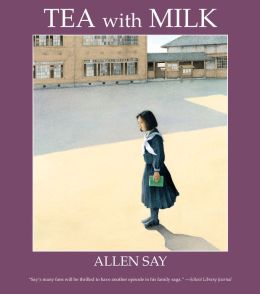TEA WITH MILK
By Allen Say

Image Credit: www.barnesandnoble.com
1. Bibliographic
Say, Allen. Tea with Milk. Boston: Houghton Mifflin, 1999. Print. ISBN 0395904951
2. Plot Summary
May was a young girl who grew up in California with her family. Her family became homesick for Japan and decided to move back when May graduated from high school. In Japan, May had to attend more school and was an outsider to others. May left home and found a job in Osaka where she worked at a department store working with customers who speak English. There she meet Joseph and they became friends.
3. Critical Analysis
TEA WITH MILK by Allen Say is historically based. This is a story about Allen Say's mother and how she struggled as a Japanese woman in Japan and how she met his father. With each page, the readers will be anxious to see what will happen next in the story. This story has a meaning that many young children may not understand. May learns that she can make a home for herself in any country including Japan. "May, home isn't a place or a building that's ready-made and waiting for you, in America or anywhere else."
Cultural markers present include the reference to kimonos that women wear in Japan and sitting for long periods of time. We also learn that May was expected to arrange flowers and write in calligraphy. "Gaijin" which means foreigner was used several times in the story. The meaning of the word could be found in the following sentence. May also refers to food that is no longer available to her including pancakes, fried chicken, and spaghetti.
The illustrations are full page with print on the facing page. The illustrations do a wonderful job of showing May's emotions. At the beginning we she her as a happy child in front of her home and the American flag. We also see the angry emotions on her face when she is back in Japan. The illustrations resemble photos with delicate detail and color.
Cultural markers present include the reference to kimonos that women wear in Japan and sitting for long periods of time. We also learn that May was expected to arrange flowers and write in calligraphy. "Gaijin" which means foreigner was used several times in the story. The meaning of the word could be found in the following sentence. May also refers to food that is no longer available to her including pancakes, fried chicken, and spaghetti.
The illustrations are full page with print on the facing page. The illustrations do a wonderful job of showing May's emotions. At the beginning we she her as a happy child in front of her home and the American flag. We also see the angry emotions on her face when she is back in Japan. The illustrations resemble photos with delicate detail and color.
4. Review Excepts
~PUBLISHERS WEEKLY (3/1999): "His exquisite, spare portraits convey emotions that lie close to the surface and flow easily from page to reader: with views of Masako's slumping posture and mask-like face as she dons her first kimono, or alone in the schoolyard, it's easy to sense her dejection. Through choice words and scrupulously choreographed paintings, Say's story communicates both the heart's yearning for individuality and freedom and how love and friendship can bridge cultural chasms."
~SCHOOL LIBRARY JOURNAL (5/1999): "This is a thoughtful and poignant book that will appeal to a wide range of readers, particularly our nation's many immigrants who grapple with some of the same challenges as May and Joseph, including feeling at home in a place that is not their own."
5. Connections
~Research more about the history of tea with milk and enjoy a serving of tea with milk
~Students can interview older generations in their family that may have moved to a different state or country with emphasis on how they adapted.
No comments:
Post a Comment